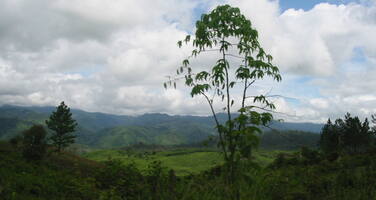Río Plátano Biosphere Reserve
Factors affecting the property in 1995*
- Ground transport infrastructure
- Identity, social cohesion, changes in local population and community
- Illegal activities
- Land conversion
Factors* affecting the property identified in previous reports
- Extreme pressure with the invasion of refugees and settlers into the Reserve;
- Illegal tree felling;
- Poaching;
- Road construction
International Assistance: requests for the property until 1995
Total amount approved : 168,000 USD
| 1988 | Equipment for Rio Platano Biosphere Reserve (Approved) | 20,000 USD |
| 1987 | Consultant services, training and equipment for ... (Approved) | 30,000 USD |
| 1985 | Strengthen protection and management of Rio Platano ... (Approved) | 20,000 USD |
| 1983 | Implementation of protective measures, of training ... (Approved) | 26,000 USD |
| 1982 | Financial contribution towards ecodevelopment ... (Approved) | 67,025 USD |
| 1982 | Rio Platano Biosphere Reserve (Approved) | 4,975 USD |
Missions to the property until 1995**
Information presented to the Bureau of the World Heritage Committee in 1995
The Centre received a report from the Fundación Río Plátano concerning the site, inscribed on the World Heritage List in 1982. The report concerns the agricultural intrusion at the Western border of the site. Additional information was obtained on 12 April 1995 on the land reform programme and its implementation in North-eastern Honduras. The settlement programme threatens several protected areas. The Centre contacted the authorities concerned to obtain further information.
Conservation issues presented to the World Heritage Committee in 1995
The Centre informed the Bureau that a report was received from the Fundación Río Plátano concerning the site, inscribed on the World Heritage List in 1982. The report concerned the agricultural intrusion at the western border of the site. Additional information was obtained on 12 April 1995 on the land reform programme and its implementation in north-eastern Honduras. The settlement programme threatens several protected areas. The Centre contacted the authorities concerned to obtain further information and has received additional reports about shortcomings of the conservation of the site by the national government. The site is seriously threatened by planned and unplanned colonization having negative effects upon the indigenous cultures, unauthorized forest operations and poaching.
The Bureau asked IUCN to verify the situation and to report back to the World Heritage Committee in December. Subsequently, the Centre received a letter from the Minister for the Environment requesting a mission to the site to evaluate the situation. The Centre contacted IUCN to define the terms of reference for such a mission. At the time of the preparation of this document the mission was under preparation and IUCN will report to the Bureau of the World Heritage Committee.
Analysis and Conclusion by World Heritage Centre and the Advisory Bodies in 1995
On the basis of the report, the Bureau may reach the conclusion that the site is seriously threatened and may wish to recommend to the Committee that the site may be placed on the List of World Heritage in Danger.
Summary of the interventions
Decisions adopted by the Committee in 1995
19 BUR VI.20
Platano Biosphere Reserve (Honduras)
The Centre informed the Bureau that a report was received from Fundaciôn Rio Platano concerning the site, inscribed on the World Heritage List in 1982. The report concerns the agricultural intrusion at the western border of the site. Additional information was obtained on 12 April 1995 on the land reform programme and its implementation in north-eastern Honduras. The settlement programme threatens several protected areas. The Centre contacted the authorities concerned to obtain further information. The Centre has received additional reports about inadequate commitment to the conservation by the national government. Planned and unplanned colonization is taking place, unauthorized forest operations, poaching of birds and game is extremely serious. Indigenous cultures are threatened by colonization of outside settlers. The World Heritage Centre advised the Permanent Delegate of Honduras the concerns in April 1995, however, no response has been received so far.requested the Centre to prepare a letter for the signature of the Chairman of the World Heritage Committee to the President of Honduras, transmitting the concerns of the Bureau.
19 COM VII.A.2.14/16
SOC: Rio Platano Biosphere Reserve (Honduras)
VII.14 Rio Platano Biosphere Reserve (Honduras)
The Committee recalled that the Bureau at its nineteenth session took note of a report received from the Fundaci6n Rio Platano concerning the site, inscribed on the World Heritage List in 1982. The report concerned the agricultural intrusion at the south and western borders of the site and on the land reform programme and its implementation in north-eastern Honduras. The Bureau at its nineteenth session requested IUCN to verify the situation and to report back to the nineteenth session of the World Heritage committee. Subsequently, the Centre received a letter from the Minister for the Environment requesting a mission to the site to evaluate the situation.
The mission was carried out by the IUCN Regional Office based in Costa Rica in November 1995. The report of the mission outlines the major threats and concludes with eleven follow-up actions, including the inscription of the site on the List of World Heritage in Danger.
The Committee took note of the report and requested the Centre to contact the authorities to obtain an official letter on the actions to be taken to protect the site.
The Bureau recommended that the full report be presented to the Committee by the representatives of IUCN before taking any decision.

Documents examined by the Committee
19COM (1995)Exports
* :
The threats indicated are listed in alphabetical order; their order does not constitute a classification according to the importance of their impact on the property.
Furthermore, they are presented irrespective of the type of threat faced by the property, i.e. with specific and proven imminent danger (“ascertained danger”) or with threats which could have deleterious effects on the property’s Outstanding Universal Value (“potential danger”).
** : All mission reports are not always available electronically.

